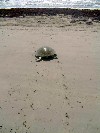 |
 | |
  | |
|
|
|
|
Padre Island National Seashore
Look For and Report Nesting
|
|
|
|
|
| |
 |
|
If you are walking or driving on the beach at Padre Island National Seashore or elsewhere on the Texas coast, here is a great way that you can help save sea turtles. Please examine the photographs on this website of nesting Kemp’s ridley turtles (two feet long) and Kemp's ridley tracks (two feet wide) and look for both while you are on the beach between April and mid-July. From late-May through August, look for hatchlings (2 inches long) emerging from previously undetected nests and crawling towards the sea.
If you find a nesting sea turtle, sea turtle tracks, or hatchlings, please IMMEDIATELY report them by flagging down a passing turtle patroller or law enforcement officer, or by calling the appropriate area coordinator. If you do not recall the number for the area coordinator, call 1-866-TURTLE5 and a recorded message will give you that number.
It is essential that you report these observations immediately so that biologists can arrive as quickly as possible to protect the turtles and eggs. Also, please report the nesting turtle as soon as you see her, so that biologists can try to get to the site to examine her before she re-enters the sea. However, please do not rush up to the nesting turtle while she is crawling up the beach to select a nest site or you may frighten her back into the water.
- Protect the nesting turtle and hatchlings from passing traffic.
- Hatchlings are difficult to see because they are so small and nesting Kemp’s ridley turtles can be very difficult to see because they sometimes nest in ruts and often nest on windy days and become partially covered with sand.
- If necessary, ask motorists to take another route to avoid damage to the turtles or nests.
- Allow the turtle to nest undisturbed.
- After the nesting turtle has started to lay the eggs or when she is returning to the water, photograph or video her and examine her for tags. Photograph or video the hatchlings as they are emerging from the nest or crawling towards the water.
- Mark where the turtle nested or where the hatchlings emerged from.
- Let the turtles enter the surf if they are crawling towards it, but do not place them in the water or touch them.
- If possible, stay at the site until an official arrives.
Your assistance is greatly appreciated and could make all the difference in ensuring the survivorship of these endangered turtles.
|
 |
Nesting ridley (3 Photos)
View these scenes of a Kemp's ridley sea turtle nesting.
|
 |
Ridley tracks (3 Photos)
Examine the tracks left by a nesting Kemp's ridley sea turtle.
|
 |
Emerging Hatchlings (4 Photos)
View sea turtle hatchlings as they emerge from their nest.
|
|
|
|

Contact Information
Follow this link to find out who to contact about nesting or stranded sea turtles in your area.
more... | |
|
|
|
|
|
|
|
 |
|
Did You Know?
The Laguna Madre is one of only six lagoons in the world termed "hypersaline" (i.e. saltier than the ocean)?
more...
|
|
|
|
Last Updated: February 17, 2007 at 13:44 EST |






